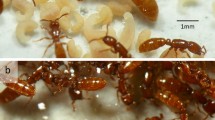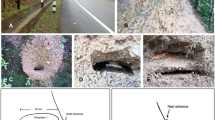Abstract
Nest architecture studies provide important information about the natural history of ants, such as number of workers in a colony and presence/absence of winged forms, larvae, pupae, and food resources. These aspects of the population biology may help answer questions related to sex ratio, kin selection, and parent-offspring conflict and to the impact of environmental conditions on the colony. Here, we describe the following aspects of the natural history of the fungus-farming ant Trachymyrmex holmgreni: (a) sex investment ratios; (b) intranidal population; and (c) external and internal nest architecture. In April 2007, we excavated ten nests of T. holmgreni in Itapeva beach in southern Brazil. In four of the ten nests, we measured height, width, and depth of all nest chambers found and counted and weighed all ant individuals in the laboratory. We found gynes and males in all four colonies, and larvae and pupae in three of them. The numerical sex ratio and the estimated sex investment in the colonies examined here suggest a higher expenditure of energy for the production of females. Our study provides new data for understanding the biology of T. holmgreni, which is a member of the Trachymyrmex iheringi group, a rather diverse group of fungus-farming ants that are closely related to leaf-cutting ants.


Similar content being viewed by others
Change history
03 January 2023
Due to ORCID ID update for co-author
References
Araujo MS, Della-Lucia TMC, Mayhé-Nunes AJ (2002) Caracterização de ninhos e atividade forrageadora de Trachymyrmex fuscus Emery (Hymenoptera: Formicidae) em plantio de eucalipto. Rev Bras Zool 19:419–427
Boomsma JJ, Isaaks JA (1985) Energy investment and respiration in queens and males of Lasius niger (Hymenoptera: Formicidae). Behav Ecol Sociobiol 18:19–27
Bourke AFG (1998) Worker reproduction in the higher Eusocial Hymenoptera. Q Rev Biol 63:291–311
Bourke AFG (2015) Sex investment ratios in eusocial Hymenoptera support inclusive fitness theory. J Evol Biol. 2106–2111
Branstetter MG, Jesovnik A, Sosa-Calvo J, Lloyd MW, Faircloth C, Brady SG, Schultz TR (2017) Dry habitats were crucibles of domestication in the evolution of agriculture in ants. Proc R Soc B 284:20170095. (https://doi.org/10.1098/rspb.2017.0095)
Brian MV (1979) Habitats differences in sexual production by two co-existent ants. J Anim Ecol 48:943–953
Diehl E (2000) Sexual investment in leaf-cutting ant Acromyrmex heyeri Forel (Hymenoptera, Formicidae). Acta Biol Leopold 22:231–218
Diehl-Fleig E (1993) Sex ratio and nuptial flight pattern of the leaf-cutting ants Acromyrmex heyeri and A. striatus (Hymenoptera, Formicidae). Insect Soc 40:111–113
Diehl-Fleig E (1995) Formigas: Organização social e ecologia comportamental. Editora Unisinos, São Leopoldo
Diehl-Fleig Ed, Diehl E (2007) Nest architecture and colony size of the fungus-growing ant Mycetophylax simplex Emery, 1888 (Formicidae, Attini). Insect Soc 54:242–247
Duarte MM, Bencke GA (2006) Plano de Manejo do Parque Estadual de Itapeva. In: Rio Grande do Sul (ed) Secretaria do Ambiente e Desenvolvimento Sustentável e Fundação Zoobotânica do, Porto Alegre
Emery C (1906) Studi sulle formiche della fauna neotropica. XXVI. Boll Soc Entomol Ital 37:107–194
Foerster A (1850) Hymenopterologische Studien 1 Formicariae. Ernt Ter Meer, Aachen, p 74
Forel A (1885) Études myrmécologiques en 1884 avec une description des organs sensoriales des antennes. Bull Soc Vaudoise Sci Nat 20:316–380
Forel A (1899) Formicidae [part]. Biol Centrali-Americana Hym 3:25–56
Frank SA (1987) Variable sex ratio among colonies of ants. Behav Ecol Sociobiol 20:195–201
Gallardo A (1916) Notas acerca de la hormiga Trachymyrmex pruinosus Emery. An Mus Nac Hist Nat de Buenos Aires 28:241–252
Gonçalves CR (1975) Formigas do gênero Serycomyrmex e Trachymyrmex cortando folhas verdes de plantas. In: Reunião da Sociedade Brasileira para o Progresso da Ciência, Belo Horizonte
Jesovnik A, Sosa-Calvo J, Lopes CT, Vasconcelos HL, Schultz TR (2013) Nest architecture, fungus garden, queen, males and larvae of fungus-growing ant Mycetagroicus inflatus Brandão & Mayhé-Nunes. Insect Soc 60:531–542
Klingenberg C, Brandão CRF, Engels W (2007) Primitive nest architecture and small monogynous colonies in basal Attini inhabiting sandy beaches of southern Brazil. Stud Neotrop Fauna E 42:121–126
Lapointe SL, Serrano MS, Petter GJ (1998) Microgeographic and vertical distribution of Acromynnex landolti (Hymenoptera: Formicidae) nests in a Neotropical. Environ Entomol 27:636–641
Latreille PA (1802) Histoire naturelle des fourmis, et recueli de memoires et d’observations sur les abeilles, les araignées, les faucheurs, et autres insectes. Impr. Crapelet (chez T. Barrois), p 445
Linnaeus C (1758) Systema naturae per regna tria naturae, secundum classes, ordines, genera, species, cum characteribus, differentiis, synonymis, locis. Tomo I. Editio decimal, Reformata. Holminae, p 824
Mayhé-Nunes AJ, Brandão CRF (2002) Revisionary studies on the Attine ant genus Trachymyrmex Forel. Part 1: Definition of the Genus and the Opulentus Group (Hymenoptera: Formicidae). Sociobiology 40:667–698
Mayhé-Nunes AJ, Brandão CRF (2005) Revisionary studies on the Attine ant genus Trachymyrmex Forel. Part 2: The Iheringi Group (Hymenoptera: Formicidae). Sociobiology 45:271–305
Mayhé-Nunes AJ, Brandão CRF (2007) Revisionary studies on the Attine ant genus Trachymyrmex Forel. Part 3: The Jamaicensis group (Hymenoptera: Formicidae). Zootaxa 1444:1–21
McCook HC (1881) Note on a new northern cutting ant Atta septentrionalis. Proc Acad Nat Sci Philadelphia 32:359–363
Mehdiabadi NJ, Reeve HK, Mueller UG (2003) Queens versus workers: sex-ratio conflict in Eussocial Hymenoptera. Trends Ecol Evol 18:88–93
Mykheyev AS, Tschinkel WR (2004) Nest architecture of the ant Formica pallidefulva: structure, costs and rules of excavation. Insect Soc 51:30–36
Mueller UG (2002) Ant versus fungus versus mutualism: ant-cultivar conflict and the deconstruction of the attine ant-fungus symbiosis. Am Nat 160:68–98
Murakami T, Higashi S, Windsor D (2000) Mating frequency, colony size, polyethism and sex ratio in fungus-growing ants (Attini). Behav Ecol Sociobiol 48:276–284
Nonacs P (1986) Sex-ratio determination within colonies of ants. Evolution 40:199–204
Rabeling C, Cover SP, Johnson RA, Mueller UG (2007a) A review of the North American species of the fungus-gardening ant genus Trachymyrmex (Hymenoptera. Formicidae) Zootaxa 1664:1–53
Rabeling C, Verhaagh M, Engels W (2007b) Comparative study of nest architecture and colony structure of the fungus growing ants Mycocepurus goeldi and Mycocepurus smithii. J Insect Sci 7:1–13
Roger J (1863) Die neu aufgeführten Gattungen und Arten meines Formiciden-Verzeichnisses nebst Ergänzung einiger früher gegebenen Beschreibungen. Dtsch Entomol 7:131–214
Seal JN (2009) Scaling of body weight and fat content in “fungus-gardening” ant queens: does this explain why leaf-cutting ants found claustrally? Insect Soc 56:135–141
Schultz TR, Brady SG (2008) Major evolutionary transition in ant agriculture. Proc Nat Acad Sci USA 105:5435–5440
Solomon SE, Mueller UG, Schultz TR, Currie CR, Price SL, Oliveira da Silva-Pinhati AC, Bacchi M Jr, Vasconcelos HL (2004) Nesting biology of the fungus growing ants Mycetarotes Emery (Attini, Formicidae). Insect Soc 51:333–338
Sosa-Calvo J, Schultz TR, Brandão CRF, Klingenberg C, Feitosa RM, Rabeling C, Bacci M Jr, Lopes CT, Vasconcelos HL (2013) Cyatta abscondita: Taxonomy, evolution, and natural history of a new fungus-farming ant genus from Brazil. Plos One 8:e80498
Sosa-Calvo J, Jesovnik A, Okonski E, Schultz TR (2015) Locating, collecting, and maintaining colonies of fungus-farming ants (Hymenoptera: Formicidae: Myrmicinae: Attini). Sociobiology 6:300–320
Sosa-Calvo J, Jesovnik A, Lopes CT, Rodrigues A, Rabeling C, Bacci M Jr, Vasconcelos HL, Schultz TR (2017a) Biology of the relict fungus-farming ant Apterostigma megacephala Lattke, including descriptions of the male, gyne, and larva. Insect Soc 79:3770–3778
Sosa-Calvo J, Jesovnik A, Vasconcelos HL, Bacci M Jr, Schultz TR (2017b) Rediscovery of the enigmatic fungus-farming ant “Mycetosoritis” asper Mayr (Hymenoptera: Formicidae): implications for taxonomy, phylogeny, and the evolution of agriculture in ants. Plos One 12:e0176498
Trivers RL, Hare H (1976) Haplodiploidy and the evolution of the social insects. Science 191:249–263
Tschinkel WR (1987) Seasonal life history and nest architecture of a winter-active ant, Prenolepis imparis. Insect Soc 34:143–164
Tschinkel WR, Bhatkar A (1974) Oriented mound building in the ant, Trachymyrmex septentrionalis. Environ Entomol 3:667–673
Vasconcelos HL, Araujo BB, Mayhé-Nunes AJ (2008) Patterns of diversity and abundance of fungus-growing ants (Formicidae: Attini) in areas of the Brazilian Cerrado. Rev Bras Zool 25:445–450
Ward PS, Brady SB, Fisher BL, Schultz TR (2015) The evolution of myrmicine ants: phylogeny and biogeography of a hyperdiverse ant clade (Hymenoptera: Formicidae). Syst Entomol. https://doi.org/10.1111/syen.12090
Weber N (1956) Fungus-growing ants and their fungi: Trachymyrmex septentrionalis. Ecology 37:150–161
Weber NA (1969) A comparative study of the nests, gardens and fungi of the fungus-growing ants, Attini. In: Ernst E et al (eds) International union for the study of social insects. Proceedings, Bern, pp 299–307
Wheeler WM (1903) A decad of Texan Formicidae. Psyche 10:93–111
Wheeler WM (1925) Neotropical ants in the collections of the Royal Museum of Stockholm. Arkiv för Zoologi 17:1–55
Acknowledgements
We would like to offer a special thanks to Christian Rabeling for comments, discussions, and suggestions for improving this manuscript, and Michael Breed and the three reviewers for detailed comments and suggestions. We also thank Aline F. Centa for assistance in weighing ants in the laboratory. This work was written in memory of Ed. Diehl-Fleig.
Author information
Authors and Affiliations
Additional information
Ed. Diehl‑Fleig: deceased on 15 August 2016.
Rights and permissions
About this article
Cite this article
Albuquerque, E.Z., Diehl-Fleig, E., Diehl, E. et al. Sex investment ratios and natural history observations in a population of Trachymyrmex holmgreni (Formicidae) in southern Brazil. Insect. Soc. 65, 297–303 (2018). https://doi.org/10.1007/s00040-018-0614-y
Received:
Revised:
Accepted:
Published:
Issue Date:
DOI: https://doi.org/10.1007/s00040-018-0614-y




